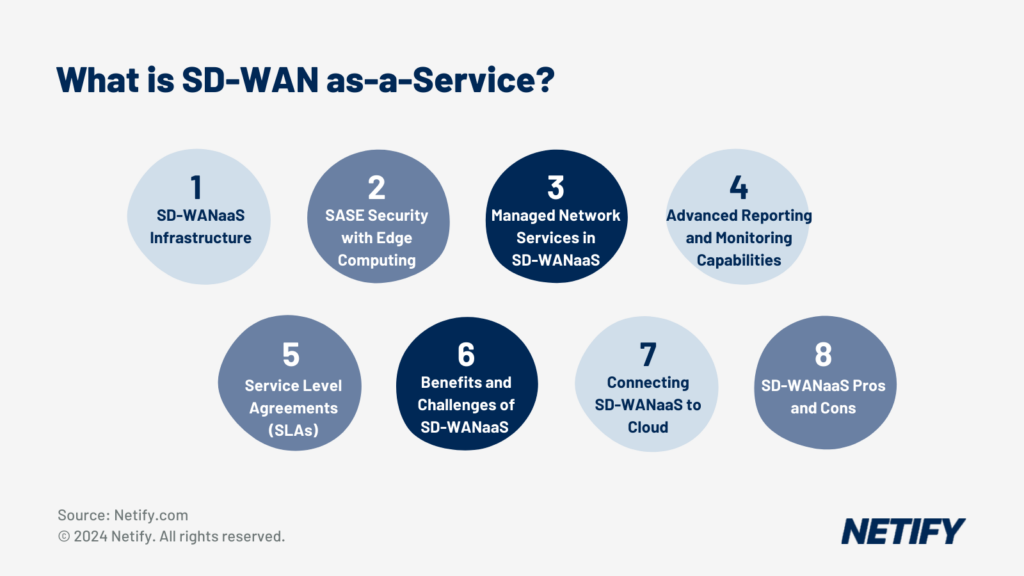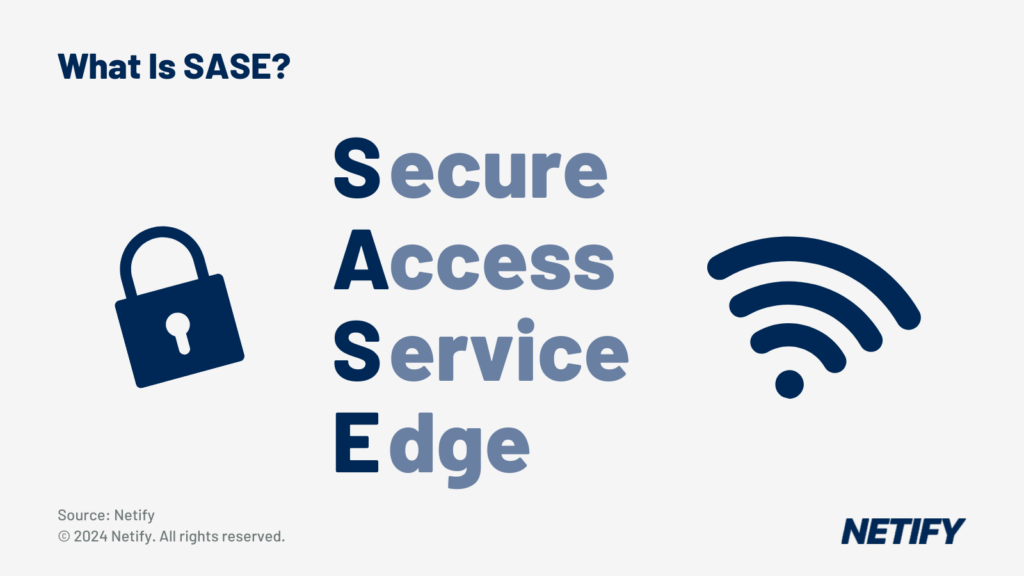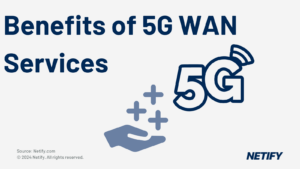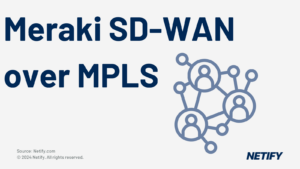| SD-WAN as-a-Service (SD-WANaaS) is a cloud-based solution providing secure, reliable connectivity for remote users. It enhances performance, security, and scalability, with benefits like quicker deployment and reduced vulnerabilities. |

SD WAN-as-a-Service (SD-WANaaS) is a cloud-powered solution that provides dependable, secure, and high-performance connectivity across remote users and business locations. This approach merges connectivity and orchestration software, effectively outsourcing a range of services for clients. In this consumption model, service providers cover licensing fees to vendors in exchange for essential capabilities, ensuring seamless network functionality for businesses.
This consumption model is advantageous for businesses as it allows them to pay a licence fee to a vendor for the required capabilities, resulting in a cost-effective solution that streamlines operations and enhances network performance.
SD WAN as-a-Service solutions extend communication, security, and management capabilities globally by using cloud technology. The cloud-based approach to SD WAN separates software from physical appliances such as Next Generation Firewall technology. It is not possible, instead of using physical appliances in deployments, to deliver software-based services directly to customers under a subscription model.
The result: network operations that are faster, more secure, reliable, and efficient than those available in traditional on-premises management environments.
Table of Contents
What is SD-WANaaS Infrastructure?
Also known as managed SD-WAN, SD-WANaaS provides a wide variety of elements that make these services possible.
Native Access to Major SD WAN as-a-Service Platforms
By providing access and shortening the distance to an SD WAN service, an SD-WAN gateway reduces signal transit times and service interruptions in modern business networks. An SD-WAN as-a-service gateway delivers easy access to cloud-based platforms, such as Amazon Web Services, Microsoft Azure, and Google Cloud.
SASE: Heightened Security via Edge Computing
The secure access service edge (SASE) framework is a new approach to network security. This framework combines SD WAN network capabilities and zero-trust security solutions on a cloud-based platform of users, systems, endpoints, and remote networks.
The main goal of SASE architecture is to provide a smooth, unbroken user experience, fast and reliable connectivity, and a wide range of security services.
SASE extends SD-WAN security capabilities by operating at a network’s edge wherever that might be, rather than next to physical appliances installed at the network’s boundary.
SASE components include these elements:
- Software-defined wide area network (SD-WAN), the foundation technology of SASEs.
- Zero trust network access (ZTNA), a set of cloud-based technologies, which operate on a special security framework.
In this framework, users are never assumed to be trustworthy, and access to secured network resources is granted only on a need-to-know, least-privileged basis.
These stringent standards help users avoid a poor experience and risks inherent in a traditional VPN.
- Secure web gateway – This web security service prevents unauthorised traffic from entering a specific network. The goal of a SWG is to identify threats before they enter a virtual network perimeter.
- Cloud access security broker – This security checkpoint between on-premises networks and cloud-based applications is where data security policies are enforced.
- Firewall as-a-service – This service moves firewall protection to the cloud instead of the traditional network perimeter.
This approach to security enables organisations to securely connect a remote, mobile workforce to the corporate network and enforce consistent security policies.
SASE platforms enable IT administrators to manage SD WAN, software gateways, CASB, firewalls as-a-service, zero-touch access via unified management, and a wide range of networking and security services.

What Is SASE? SASE stands for Secure Access Service Edge - SASE stands for Secure Access Service Edge
SASE = Security + SD WAN Technologies
There are plenty of reasons why cyberattacks continue to grow in number and sophistication. Demand for public cloud services and the trend for highly distributed computing environments continue, as do massive movements of network data, controlled from a centralised desk at a data centre.
But these changes in technology and work environments create benefits and potential problems in mitigating security threats and preventing security breaches. SD WANaaS extends efficiency by automating antivirus and threat intelligence responses, reducing response times from days or weeks to seconds or minutes.
Managed Network Services
SD-WAN as-a-Service (SD-WANaaS) delivers a robust suite of managed network solutions to enhance business operations, including:
Orchestration streamlines the process of configuring and deploying services on the SD-WAN platform by providing customers with web portal access. It automates service delivery, reducing manual intervention and simplifying network management.
Scalability is one of the earliest innovations offered by telcos, SD-WANaaS enables companies to easily modify network bandwidth according to fluctuating needs. This adaptability ensures optimal performance and cost-efficiency, while eliminating the requirement for human attention in adjusting bandwidth allocations.
Reporting Methods
Advanced SD-WAN reporting techniques utilise AI-powered automation to monitor, log, and analyse network traffic data. By employing historical event reporting, these methods assess the impact of network traffic changes on application delivery, helping to optimise SD-WAN configurations. This streamlined approach enables IT teams to make data-driven decisions, ultimately enhancing network performance and application delivery across SD-WAN infrastructures.
Service Level Agreements
Service level agreements (SLAs) provide a pillar of SD WAN as-a-service quality assurance. These agreements deliver a detailed list of minimum-level services, objectives, and responsibilities for all parties involved in a service.
Managed SD WAN services are often supported by service-level agreements (SLAs). These agreements provide a well-defined, minimum performance and reliability standard, which may not be assured in an on-premises deployment.
The Latest in Data-Secure Connectivity and Management
So, what are the differences between SD WAN and its as-a-service cousin? These features distinguish the latest in data connectivity and network management.
Global reach
As international businesses expand, their need for reliable and efficient network solutions becomes increasingly crucial. SD-WAN as-a-Service (SD-WANaaS) addresses these demands by providing comprehensive networking capabilities through a worldwide network of points of presence (PoPs).
Utilising a global network of strategically positioned PoPs, SD-WANaaS vendors ensure that companies have access to high-performance and low-latency network connectivity, regardless of their geographical location. This approach optimises network traffic, enhances application performance, and provides seamless connectivity between branches, data centres, and cloud services.
A global PoP infrastructure also empowers organisations with increased network resilience and redundancy. In the event of an outage or failure in one location, network traffic can be swiftly rerouted through alternative PoPs, ensuring minimal disruption and maintaining business continuity.
SD-WANaaS offers centralised management capabilities, simplifying the deployment, monitoring, and maintenance of network infrastructure for global companies. This allows organisations to efficiently manage their network resources across multiple locations, reducing the need for dedicated IT staff at each site.
SD-WANaaS vendors often provide advanced security features, such as end-to-end encryption and secure remote access, which are essential for protecting sensitive data and maintaining compliance with industry regulations.
By leveraging a worldwide network of PoPs, SD-WANaaS vendors can accommodate the unique requirements of international businesses and support their ongoing growth and success.
Optimised business connectivity
How do we know if business connectivity is the best that it can be? Some indicators include:
- Users have easy access to an organisation’s expanding cloud infrastructure.
- A network provides an unbroken extension of a WAN to multiple public clouds throughout the world.
- The network provides optimised, real-time performance for Microsoft Office 365, Salesforce, and other popular SaaS applications.
- The network is optimised to for access to cloud platforms for optimal application performance.
Service-level agreements
Managed SD WAN services are commonly backed by service-level agreements (SLAs). This approach to services ensures a clearly defined, minimum level of performance and reliability, which might not be guaranteed with an on-premises deployment agreement.
If your organisation is considering an as-a-service solution, an SLA offers guarantees across network performance but also support and delivery. The figures outlined with the SLA are key to understanding how the service will ultimately perform.
SD WANaaS Tech: Benefits and Challenges
In addition to improved security capabilities, SD WANaaS provides benefits that reduce the time, effort, and costs of network operation.
Benefits That Improve Speed and Efficiency
- SASE solutions improve UX by providing distributed security based on software-as-a-service (SaaS) delivery. This approach makes data sharing more efficient and ensures that security policies align with security data.
- Faster SD WAN deployment at remote sites and branch offices. SD WAN solutions connect branch networks and remote employees to corporate resources, quickly and efficiently, no matter where they are located.
- Better application performance and quality of service (QoS). Improved performance is a key reason to choose SD WAN technology. Optimised traffic means less network latency, packet loss, and jitter on the network.
- Timely, relevant reporting and analytics. Data and reports generated in SASE solutions ensure smooth network operations and provide data needed to set up network configurations.
Transitioning from WAN to SD WAN involves replacing physical appliances with software licences. This change presents new challenges for IT operations teams, such as:
- SD WAN introduces a different approach to WAN management, potentially necessitating a lengthy and costly talent search or on-site IT training.
- Implementing SD WAN increases short-term costs due to the need for additional software licensing
- Although maintaining IT infrastructure becomes less of a concern, expect to invest more time and money into managing the personnel who oversee the IT infrastructure.
Furthermore, anticipate costs related to meeting new company requirements across IT and human resources within your organisation. For public companies, be prepared to address potential tax implications.
Connecting SD WANaaS to Cloud Providers
You’re likely familiar with the advantages of SD-WAN. However, the way your SD WAN connects to your cloud and the benefits you gain largely depend on your WAN’s capabilities.
Three steps to connect SD WAN to Cloud Providers
When considering the integration between SD-WAN as-a-service and AWS, Azure, and Google Cloud, it’s crucial to focus on three main aspects: deployment simplicity, management and monitoring capabilities, and security and compliance features.
Step 1: Analyse ease of deployment and compatibility
- Confirm that the SD-WAN provider offers pre-configured virtual appliances or images in the cloud platform marketplaces (AWS Marketplace, Azure Marketplace, and Google Cloud Marketplace), ensuring a streamlined deployment process.
- Make sure the provider facilitates seamless compatibility with each cloud platform’s native networking and security elements, including VPCs, VNets, subnets, route tables, and security groups.
Step 2: Evaluate management and monitoring capabilities
- Determine whether the SD-WAN provider delivers a comprehensive management console for overseeing connectivity across multiple cloud platforms.
- Investigate if the provider can integrate with the cloud platform’s native management and monitoring solutions, such as AWS CloudWatch, Azure Monitor, and Google Cloud Operations Suite (formerly Stackdriver).
- Confirm the provider’s ability to support advanced features like automated routing, application-aware traffic steering, and quality of service (QoS) management across all cloud platforms.
Step 3: Review security and compliance features
- Make sure the SD-WAN provider supports end-to-end encryption and maintains secure communication channels between on-premises and cloud environments.
- Investigate the provider’s ability to integrate with native security features of the cloud platforms, including AWS Shield, Azure DDoS Protection, and Google Cloud Armor, to bolster security.
- Verify that the SD-WAN provider adheres to necessary compliance standards, such as GDPR, HIPAA, or PCI-DSS, depending on your organisation’s specific requirements.
By carefully examining the integration levels between the SD-WAN service and the cloud platforms, you can select a solution that meets your organisation’s needs in terms of deployment, management, and security.
Other Benefits of SD WANaaS
SD WANaaS offers improved network performance compared to on-premises alternatives, but what other capabilities support these WAN optimisation features?
Reduced Risk of Cyberattack
A major concern for CISOs is cyberattacks and information security breaches. Risks are heightened when IT professionals don’t utilise application-aware policies, end-to-end segmentation, real-time access control, integrated threat protection, or secure network traffic across the public internet. Employing next-generation firewalls, DNS security, and next-generation antivirus software can help distribute security services to branch and remote endpoints.
Optimised Business Connectivity
A well-functioning network offers users faster, more reliable access to network resources within an expanding cloud infrastructure. WANs extend seamless connections to multiple public clouds worldwide, providing enhanced efficiency apps with improved reliability and supporting workflows across major cloud platforms like Amazon Web Services.
Improved Application Performance
Indicators of improved application performance include consistently high availability, predictable service for all critical applications, the utilisation of multiple hybrid links in all network scenarios, and the dynamic, automatic routing of application traffic using application-aware routing for efficient delivery and an enhanced user experience. Replacing costly multiprotocol label switching (MPLS) services with more affordable and flexible broadband communications can lead to more efficient operations.
Lower Capital and Operations Costs
Cost savings are not limited to reduced human time and effort. Regular equipment refresh cycles also involve fewer purchases. Vendor services replace on-premises, centralized management functions, and substituting hardware appliances (physical firewalls) or expensive MPLS with cloud services offers more affordable ways to secure the corporate WAN.
Advanced Reporting and Data Analytics
Most SD WAN solutions employ automated, real-time monitoring and historical reporting (logging) services to assess whether changes to network traffic policies will enhance application performance. Analytical results lead to faster security responses, threat intelligence, and other security management tasks.
SD-WANaaS Pros & Cons
| wdt_ID | wdt_created_by | wdt_created_at | wdt_last_edited_by | wdt_last_edited_at | Pros | Cons |
|---|---|---|---|---|---|---|
| 1 | hyelland | 23/10/2024 12:04 PM | hyelland | 23/10/2024 12:04 PM | Provides organisations with SD WAN functions when the IT team cannot–or chooses not to—operate their own, cloud-based, SD WAN capabilities. | Increases administrative complexity for service providers. |
| 2 | hyelland | 23/10/2024 12:04 PM | hyelland | 23/10/2024 12:04 PM | Service providers do much of the work to organize, deploy, configure, and maintain SD WAN solutions.) | |
| 3 | hyelland | 23/10/2024 12:04 PM | hyelland | 23/10/2024 12:04 PM | Replace the effort and costs of dedicated private WAN networks. | |
| 4 | hyelland | 23/10/2024 12:04 PM | hyelland | 23/10/2024 12:04 PM | As service solutions minimize the costs and IT effort of DIY managing corporate infrastructure and connectivity. | |
| Pros | Cons |
SD-WAN Pros & Cons
| wdt_ID | wdt_created_by | wdt_created_at | wdt_last_edited_by | wdt_last_edited_at | Pros | Cons |
|---|---|---|---|---|---|---|
| 1 | hyelland | 23/10/2024 12:05 PM | hyelland | 23/10/2024 12:05 PM | Rapid security setup. SD WAN solutions provide template-based, zero-touch provisioning for all campus, branch, and cloud locations. | Network Infrastructure: On-premises SD WAN points of presence (PoPs) are commonly connected over the public Internet, which offers uneven reliability and performance. |
| 2 | hyelland | 23/10/2024 12:05 PM | hyelland | 23/10/2024 12:05 PM | Centralised management: Can be linked to dedicated, optimised network infrastructure. | SD WAN appliances: In on-premises deployments, organisations might deploy a mix of physical and virtualised SD WAN appliances in on-premises and cloud-based infrastructure. |
| 3 | hyelland | 23/10/2024 12:05 PM | hyelland | 23/10/2024 12:05 PM | Easy-to-use dashboard: SD WAN designProvides a single, centralized, cloud-delivered management dashboard. | Lack of IT pro experience: In on-premises, deployments, IT pros might lack crucial IT skills and experience. |
| 4 | hyelland | 23/10/2024 12:05 PM | hyelland | 23/10/2024 12:05 PM | Flexible data management: Dashboard is used to configure, manage, and secure WAN functionality. | Lack of end-to-end quality of service agreements |
| 5 | hyelland | 23/10/2024 12:05 PM | hyelland | 23/10/2024 12:05 PM | Reporting functions: Capabilities include detailed reporting of application and WAN performance for business analytics and bandwidth forecasting purposes. | Lack of detailed SLAs along the Internet backbone |
| Pros | Cons |


